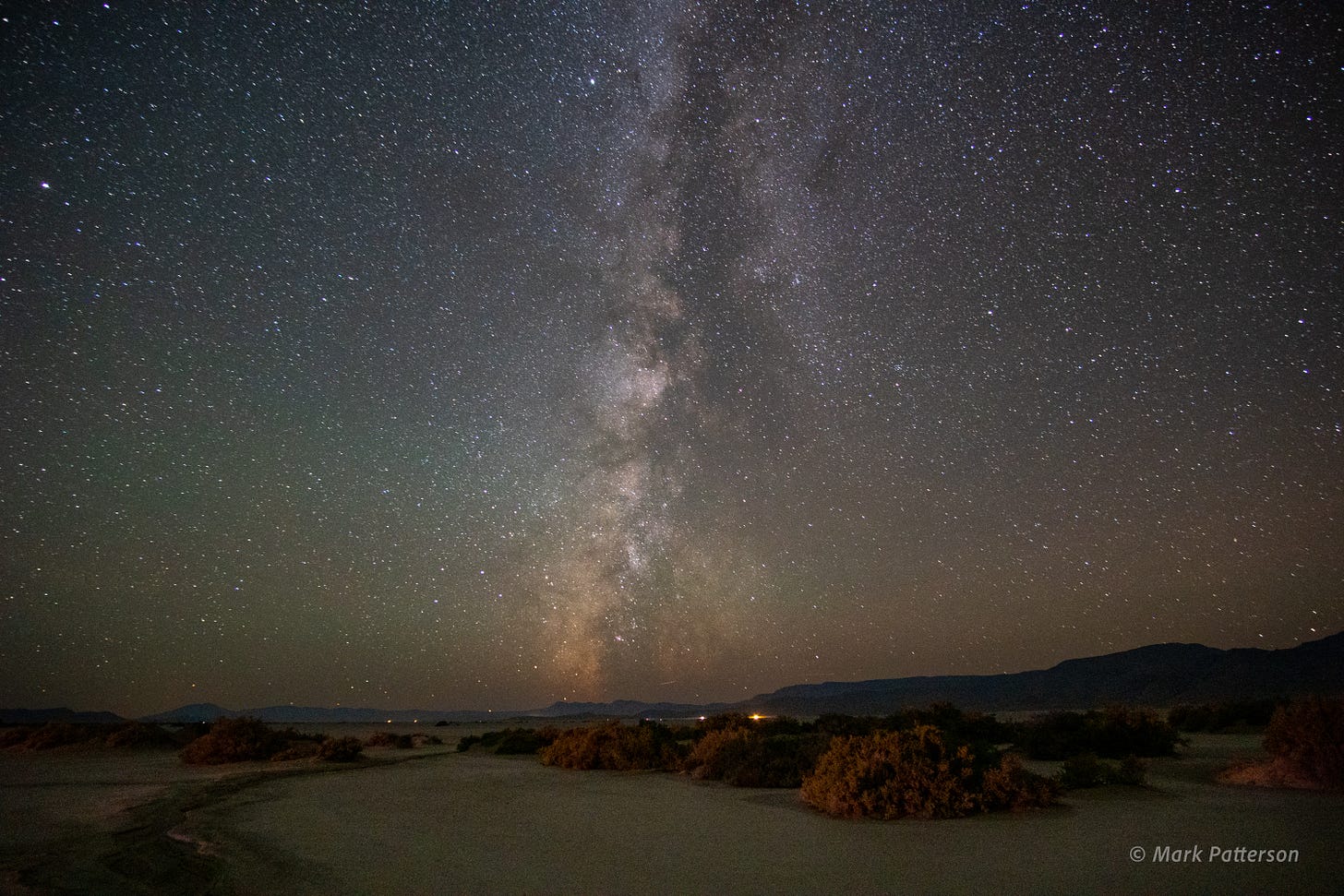The Desert, the Stars, and Thou
“We had the sky up there, all speckled with stars, and we used to lay on our backs and look up at them, and discuss about whether they was made or only just happened. Jim he allowed they was made, but I allowed they happened; I judged it would have took too long to make so many. Jim said the moon could 'a' laid them; well, that looked kind of reasonable, so I didn't say nothing against it, because I've seen a frog lay most as many, so of course, it could be done. We used to watch the stars that fell, too, and see them streak down. Jim allowed they'd got spoiled and was hove out of the nest.”
- Mark Twain, “The Adventures of Huckleberry Finn”
I was out in the desert this last weekend with great friends. It was fabulous. I didn’t do any night photography this trip but a couple of my friends did (I took the picture above last September). We were where the sky is dark, except for the stars and planets and moon and the Milky Way lighting up the sky.
When you take a picture of the stars, if you expose too long, like 30 seconds, the motion of the earth will cause the picture to capture stars not as a dot, but as a streak. If you capture for hours, these star streaks will circle the North Star.
This makes me wonder: this is observable to even flat-earthers. Being a ridiculously curious person, I wondered how these people explain this. I mean, the North Star is, you know, north. Not directly above us. Unless you’re at the North Pole, which we know doesn’t exist. And if you are a bit south of the equator (which also doesn’t exist) you can’t see the North Star at all.
So the stars spin around lopsidedly around the North Star. Do flat-earthers think the whole sky spins? Or that we’re on a wobbling platter that spins like a vinyl record? Now, if I apply logic to this theory, I have to think that they think the earth is completely stationary and the sky revolves around the North Star. The fact that the sun travels at a different arc and that we see different stars at different times of year - that must be for entertainment value. It would be boring to see the same thing all the time, I guess.
Math, of course, is hard, and therefore off the table. If math was on the table, doing the math to account for the movement of the stars, planets, moons, and galaxies if we were on a completely flat, stationary earth is daunting, to say the least. The positions of the stars and the sun in January are very different from what they are in June, with some new stars appearing and others going, only to scramble to reform themselves back into position in January again, year after year.
I guess it is obvious that Copernicus was really bad at math and gave up, because he just punted and said the earth moves, not the sun. Imagine that! He just didn’t try hard enough. I mean it’s obvious: we jump up, and land in the same damned place.
This weekend I was in a place that was flat enough that you could actually measure the Earth’s curve. It only takes a few miles of flat land to prove it. It would actually be a good school project: take a team of kids and flat-earthers to the desert with good binoculars and some long poles that are marked off with foot lines, have them mount the long poles perpendicular on one side of the space and go about seven or eight miles away, mount the binoculars at five feet and exactly parallel to the ground, and see what you see on the pole. It won’t be the five foot mark. And then observe what number you see at the horizon. It won’t be the bottom of the pole. You won’t see the bottom of the pole. Because the earth, she curves away.
Flat-earth believers show us something about humans. We humans can and will believe in anything, and we will apply logic to support things that are empirically false. Our ability to build structures of logic upon completely erroneous assumptions and assertions is astounding. We must always examine our priors and question our assumptions so that we can either shore up or tear down our logical structures of belief and conjecture that are based on them.
As I stood on the flat desert floor this weekend and looked across to the ancient lake bed’s shoreline, and noticed that I didn’t see the actual shoreline, but just a few feet above it, I thought about how lucky and blessed I am to have good friends who know we are on this wonderful orb, and that we are taking this journey through the stars together.



Our ability to perceive is tarnished by what we think we know. Only when I assume I know nothing are my eyes opened. I love seeing. 😊
Good lord, man! That is a crazy beautiful image! And your opening with Huck and Jim, perfection. What a lovely ride. Thank you!